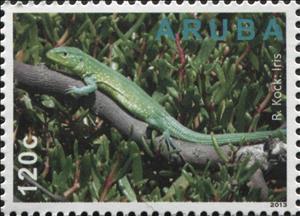Stamp: R. Kock: Lizard (Aruba 2013)
R. Kock: Lizard (Aruba 2013)
12 November (Aruba ) within release Aruban Nature - Photography goes into circulation Stamp R. Kock: Lizard face value 120 Aruban cent
| Stamp R. Kock: Lizard in catalogues | |
|---|---|
| Michel: | Mi: AW 769 |
| Stanley Gibbons: | Sg: AW 735 |
| WADP Numbering System - WNS: | WAD: AW063.13 |
Stamp is horizontal format.
Also in the issue Aruban Nature - Photography:
- Stamp - Lara Kuiperi: Cactus Landscape face value 120;
- Stamp - Lara Kuiperi: Beach face value 120;
- Stamp - Stan Kuiperi: Landscape face value 120;
- Stamp - Joost Horward: Owls face value 120;
- Stamp - R. Kock: Lizard face value 120;
- Stamp - Melissa Sweerts: Pond face value 120;
- Stamp - Bruce Harms: A Treasure face value 120;
- Stamp - Eddie Thodé: Hummingbird face value 120;
- Stamp - J. Dania: Coral Tree Blossom face value 120;
- Stamp - Lara Kuiperi: Three Asses face value 120;
- Se-tenant - Block of 10, Aruban Nature - Photography face value 10*120;
- Full Pane - Aruban Nature face value 20*120;
Stamp R. Kock: Lizard it reflects the thematic directions:
Animals are multicellular, eukaryotic organisms of the kingdom Animalia (also called Metazoa). All animals are motile, meaning they can move spontaneously and independently, at some point in their lives. Their body plan eventually becomes fixed as they develop, although some undergo a process of metamorphosis later on in their lives. All animals are heterotrophs: they must ingest other organisms or their products for sustenance.
A photographer (the Greek φῶς (phos), meaning "light", and γραφή (graphê), meaning "drawing, writing", together meaning "drawing with light") is a person who uses a camera to make photographs.
Photography is the art, application, and practice of creating images by recording light, either electronically by means of an image sensor, or chemically by means of a light-sensitive material such as photographic film. It is employed in many fields of science, manufacturing (e.g., photolithography), and business, as well as its more direct uses for art, film and video production, recreational purposes, hobby, and mass communication. A person who captures or takes photographs is called a photographer.
Reptiles are tetrapod (four-limbed vertebrate) animals in the class Reptilia, comprising today's turtles, crocodilians, snakes, amphisbaenians, lizards, tuatara, and their extinct relatives. The study of these traditional reptile orders, historically combined with that of modern amphibians, is called herpetology. Because some reptiles are more closely related to birds than they are to other reptiles (e.g., crocodiles are more closely related to birds than they are to lizards), the traditional groups of "reptiles" listed above do not together constitute a monophyletic grouping (or clade). For this reason, many modern scientists prefer to consider the birds part of Reptilia as well, thereby making Reptilia a monophyletic class.




